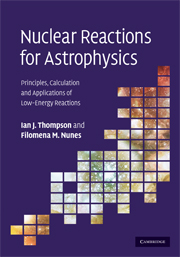Book contents
- Frontmatter
- Contents
- Preface
- Sources of quotations
- Acknowledgements
- 1 Nuclei in the Cosmos
- 2 Reactions of nuclei
- 3 Scattering theory
- 4 Reaction mechanisms
- 5 Connecting structure with reactions
- 6 Solving the equations
- 7 Approximate solutions
- 8 Breakup
- 9 Three-body nuclei
- 10 R-matrix phenomenology
- 11 Compound-nucleus averaging
- 12 Stellar reaction rates and networks
- 13 Connection to experiments
- 14 Spectroscopy
- 15 Fitting data
- Appendix A Symbols
- Appendix B Getting started with Fresco
- Select bibliography
- Index
5 - Connecting structure with reactions
Published online by Cambridge University Press: 05 March 2012
- Frontmatter
- Contents
- Preface
- Sources of quotations
- Acknowledgements
- 1 Nuclei in the Cosmos
- 2 Reactions of nuclei
- 3 Scattering theory
- 4 Reaction mechanisms
- 5 Connecting structure with reactions
- 6 Solving the equations
- 7 Approximate solutions
- 8 Breakup
- 9 Three-body nuclei
- 10 R-matrix phenomenology
- 11 Compound-nucleus averaging
- 12 Stellar reaction rates and networks
- 13 Connection to experiments
- 14 Spectroscopy
- 15 Fitting data
- Appendix A Symbols
- Appendix B Getting started with Fresco
- Select bibliography
- Index
Summary
Winning the (Nobel) prize wasn't half as exciting as doing the work.
Maria MayerIn the previous chapter we presented non-elastic mechanisms based on rotational or vibrational models, and on transfer, capture and knockout reactions based on the separation of a nucleus into a nucleon and a core cluster. In this chapter we see how the necessary properties of these structure models may be related to nuclear structure theories that should be more exact because they are microscopic and take all the many nucleons of the nuclei into account. It is beyond the scope of this book on reactions to discuss detailed methods and numerical examples using microscopic models, so we adopt the aim of establishing a ‘common language’ between structure and direct-reaction theories. In particular, we show how masses, sizes, folding potentials, overlaps and other matrix elements may be defined in terms of structure models and then used for reaction calculations.
Summary of structure models
A nucleus contains a number A of nucleons, all pairs ij of which interact with each other by a nucleon-nucleon potentialV(2) (ri-rj) which is strongly repulsive at short distances (rij ≡ |ri-rj|≾ 1 fm), attractive at medium distances (1fm ≾ rij ≾ 4fm), while protons repel even at large distances. There may also be three-body forces between bodies ijk according to some form V(3) (ri-rj, ri-rk). In general, V(2) and V(3) depend also on the spin states of the interacting nucleons, and should therefore be expanded on a sufficiently complete set of vector and tensor operators.
Information
- Type
- Chapter
- Information
- Nuclear Reactions for AstrophysicsPrinciples, Calculation and Applications of Low-Energy Reactions, pp. 173 - 199Publisher: Cambridge University PressPrint publication year: 2009
